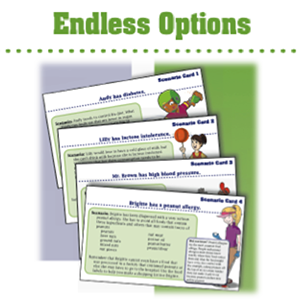 Relevancy and Engagement
agclassroom.org/
Relevancy and Engagement
agclassroom.org/

Endless Options
A 30-minute activity teaching students about food allergies, reading food labels to identify allergens, and food substitutions. It can be added to any lesson on food labels, nutrition, etc.
Time to Complete
Materials
- Food Labels
- Diet Scenario Cards
Procedures
Following a special diet or having a food allergy used to mean having limited food choices. Today people with special dietary needs or food allergies have many more choices. Product developers use innovative ingredients so that people with special dietary needs such as gluten intolerance, diabetes, or high cholesterol have flavorful food options to choose from. With this activity students will learn about the challenges presented by special diets and the options available today.
Teacher Preparation:
Ask students to bring in food labels. Make sure the boxes/cans/wrappers represent various dietary needs. Specifically look for packages labeled as:
- gluten-free
- low in sugar
- foods that use low-calorie sweeteners
- low in carbohydrates
- containing no lactose, milk, milk powder, whey, whey solids, and so forth
- low in sodium
- containing no peanuts
Questions to introduce activity:
- What is a food allergy?
- A food allergy is a disorder with the body's immune system in response to a specific food protein. Some people's symptoms are mild; others' are life-threatening. Actual food allergies must be diagnosed by a doctor; sensitivity to a particular food is not necessarily the same as an allergy.
- What are the eight major food allergens?
- Wheat, soy, milk, eggs, fish, shellfish, peanuts, and tree nuts. All of these must be labeled.
- What are some special diets that people may have to follow?
- Dairy free, low fat, low sugar/low carb, high fiber, gluten free, low sodium, low cholesterol, etc.
- What are some reasons that people may have to follow a special diet?
- Allergies, lactose intolerance, diabetes, high cholesterol, high blood pressure, gluten intolerance, to lose weight, digestive problems, etc.
- Is diet the only factor that affects these conditions?
- No. Heredity and lifestyle have an impact, too.
*Point out that processed food must list the food's ingredients and nutritional information on the label and the eight major allergens are labeled separately. Give students a chance to look at various food labels.
- How is a food label valuable to someone with special dietary needs?
- It helps them avoid foods that they could have an allergic reaction to, helps them locate foods that fit a special diet, etc.
Activity:
- Display the food labels on a table. Break the class into four groups. Provide each group with a special diet scenario card. Ask the students to use the food labels and the Internet to create a grocery list that matches each person's needs.
- After groups have finished their lists, allow students to share how food labels help them locate foods that meet specific dietary restrictions. Discuss the options available to people today and the choices they have. As a finale, do a taste test with a food item that has reduced sodium, fat or sugar and the comparable regular product. Do students feel that people with dietary restrictions have good-tasting alternatives?
File, Map, or Graphic
Author
Organization
Sources
Text and design by The Education Center, LLC. The development of this curriculum is made possible, in part, by a grant from Farm Credit. Copyright 2013.